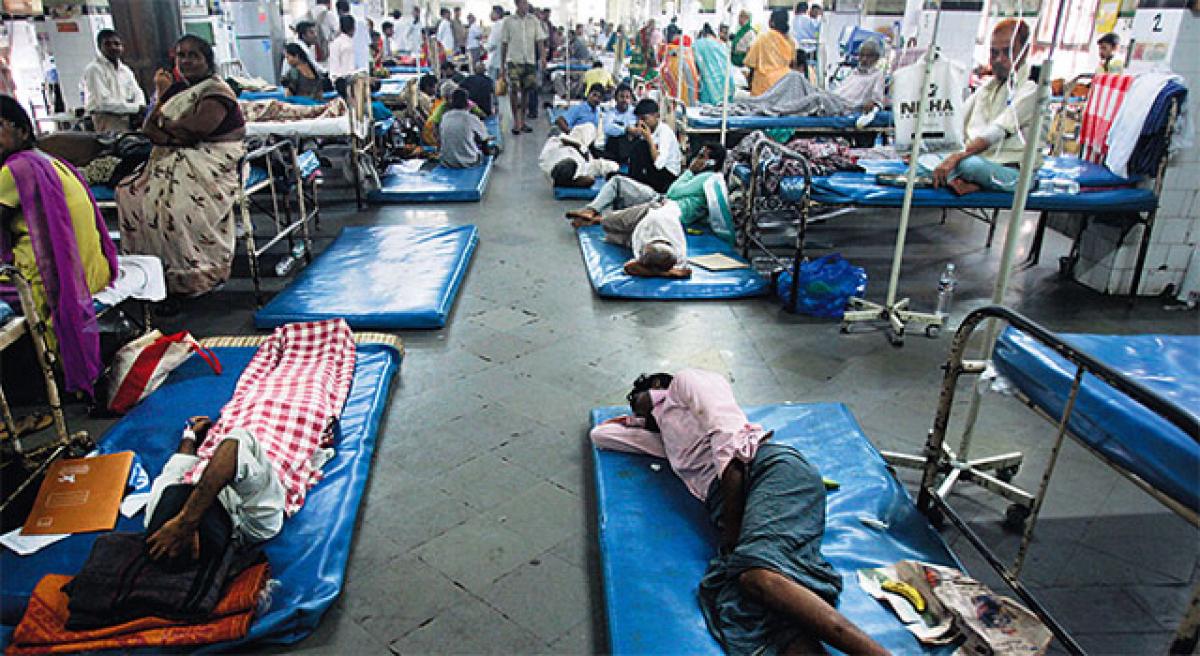Live
- Over 7,600 Syrians return from Turkiye in five days after Assad's downfall: minister
- Delhi BJP leaders stay overnight in 1,194 slum clusters
- Keerthy Suresh and Anthony Thattil Tie the Knot in a Christian Ceremony
- AAP, BJP making false promises to slum dwellers for votes: Delhi Congress
- 'Vere Level Office' Review: A Refreshing Take on Corporate Life with Humor and Heart
- Libya's oil company declares force majeure at key refinery following clashes
- Illegal Rohingyas: BJP seeks Assembly session to implement NRC in Delhi
- Philippines orders full evacuation amid possible volcanic re-eruption
- Government Prioritizes Welfare of the Poor, says Dola Sri Bala Veeranjaneyaswamy
- Two Russian oil tankers with 29 on board damaged due to bad weather
Just In

Health has remained an issue for decades. Out-of-pocket expenses, the euphemism for increasing individual spending on seeking health assistance, is eroding incomes. Public health care unfortunately has remained in unenviable state.
Health has remained an issue for decades. Out-of-pocket expenses, the euphemism for increasing individual spending on seeking health assistance, is eroding incomes. Public health care unfortunately has remained in unenviable state.
Amidst this the NITI Aayog (NY) has pitched for public private partnership (PPP) model to improve health services in the country against the backdrop of dismal performance of public hospitals at district level. In other words, it suggests virtual handing over the district hospitals built by State governments to private sector for 30 years, two generations!
Despite the State governments spending, hospital services have not improved the way these should. The high population, despite its dividend in some areas, is a deficit in health. Infrastructure is over-burdened and India faces the twin epidemic of continuing and emerging infectious diseases as well as chronic degenerative diseases.
India faces high burden of disease because of lack of environmental sanitation and safe drinking water, under-nutrition, poor living conditions, and limited access to preventive and curative health services. Expenditure on health by the government continues to be low. It is not viewed as an investment but rather as a dead loss.
NY’s prescription for handing over even the rudimentary public services to the private sector is apparently a desperate move. It is based on the premise that the State is unable to invest and there has to be a system even at public cost. The NY possibly has not taken into account that private sector involvement adds to the cost of delivery and further burdens the people with additional expenses draining their resources.
The nation has been reinventing the wheel for a long time. In between the rise of the insurance industry has led to another situation. Those having medi-claims are billed too high against the normal costs. The malaise of the sector is deep and complex.
The way the government brought down the prices of several drugs and equipment is a testimony that the pharma industry is more interested in its profits than the welfare of the people. Opening up public district hospitals to the private industry would change the shape of health care is a bit over-expectation.
In many cases, where such liaison was tried to be established, it was found not only in India but elsewhere that it ended up in benefitting the private sector and the costs to the care-seekers increased manifold.
Thus despite possible good intention, the NY apparently has given a quick draft to solve the deep-rooted problem, which is how to raise the finances for this critically important sector. Any ailment leads to losses to the suffering people – the high costs of treatment and wage loss.
The sector needs large funding. According to the Union Budget 2017, the allocation for Health Ministry for 2017-18 is Rs 47,352.51 crore in comparison to allocation in 2016-17 of Rs 37,061.55 crore, an increase of 27.76 per cent from previous year. The revised allocation for 2016-17 was Rs 38,343.33 crore. But this was above the 20 per cent cut in budgetary allocation in 2014-15 due to fiscal strains.
States also add to this. Compared to even the road sector the allocations are too little. In 2015-16, expenses for the road sector were from Central Road Fund (CRF) collections of Rs 69,809 crore in 2015-16 and Rs 54787.21 crore from 2012 to 2015. The CAG noted burdening users of Rs 28,361 crore while providing benefits to private parties by fixing a longer concession period.
The CAG said the NHAI failed to fulfill the role assigned to it by the government and provided undue benefits to three large corporates. That is the crux. The benefits in a PPP model go to the so-called service providers. Health is too delicate a sector. The NY’s proposal to link it to PPP is fraught with danger. The leakages are likely to be large and benefits negligible. India has an abysmal doctor-patient ratio.
Unless India produces more doctors, whether for the public or private sector, healthcare delivery will not improve. The NY draft is faulted for another reason. It has not done the study at the ground level. The people should have been asked about their needs, problems and expectations.
The number of users at any government hospital is high and so is the workload on the skeletal medical staff. NITI Aayog should not suggest simplistic solutions. It needs to redo a holistic study on the health system all over the country. Different States have different experiences and needs. The model has to be State-specific and not omnibus. No way can it be a PPP model to burden the users.
By Shivaji Sarkar

© 2024 Hyderabad Media House Limited/The Hans India. All rights reserved. Powered by hocalwire.com







